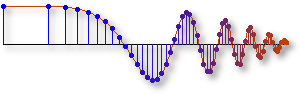First-Order IIR Filters
Earlier we learned that first-order IIR filters (also called feedback filters) of the form:$$y[n]=a\, y[n-1] + x[n]$$
have an impluse response given by:
Usually the parameter \(a\) is taken to be a real number. However, if \(a\) is chosen to be complex, then the impulse response of the first-order IIR filter can be written as:
Thus, an oscillating signal (sinusoid) can be produced by specifying
the appropriate value for \(a\) and taking either the real
or imaginary part of the impulse response.
Examples
In the first example let's set the feedback coefficient \(a\) to be: \(a=1 e^{j \pi/4 } \)
In MATLAB we can generate the output using the filter
command. Here are the series of MATLAB commands that will generate
the first order oscillator:
imp=([0:33]==0); % <-- length 34 impulse
y=filter(1,[1 -exp(j*2*pi/8)],imp); % <-- filter the impulse
plot(real(y)) % <-- take the real part
Below is the resultant plot. Note that the "period" of the
sinusoid is 8 samples and the digital frequency is therefore
\(\frac{2\pi}8\).

Let's try another example. This time we'll use
\(a=1 e^{j \pi/10}\)
imp=([0:40]==0); % <-- length 41 impulse
y=filter(1,[1 -exp(j*2*pi/20)],imp); % <-- filter the impulse
plot(real(y)) % <-- take the real part
Below is the resultant plot.

This time the frequency of the oscillator is
\(\frac{2\pi}{20}\).
Clearly the angle of the feedback term is equal to the frequency of
oscillation.
Second-Order IIR Filters
We also learned about second-order IIR (feedback) filters. Assuming that the poles of the IIR filter are complex, we know that the impulse response will have the following form: $$h[n] = A r^n \cos(n\theta + \phi).$$ Assuming the filter coefficients to be strictly real implies that the poles of the filter will occur in conjugate pairs:
Expanding the factored polynomial shows the relationship between the filter coefficients, \(a_1\) and \(a_2\), and the magnitude and phase of the poles:
Remember, the above relationship holds only when the poles are conjugate
pairs. By setting \(a_2 = -1\) we
can ensure that the oscillator does not decay with time. Now by
simply varying \(a_1\) we can control
the frequency of oscillation. Below are some examples that
demonstrate the relationship between filter coefficients, pole
locations and frequency of oscillation.
Example:\(a_2\) Fixed, Variable \(a_1\)
In these examples, we will fix \(a_2 = -1\) and observe the oscillator output and pole/zero plot as \(a_1\) is varied from \(2\, \cos(\frac{\pi}6)\) to \(2\, \cos(\frac{\pi}3)\).
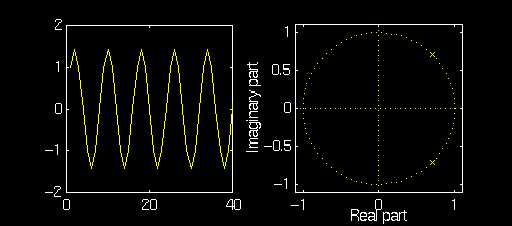
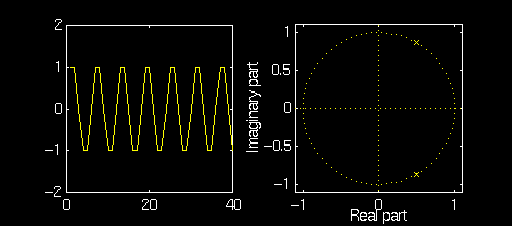
Note how the magnitude of the poles remains equal to one but the
angle changes with \(a_1\).
Also note how the amplitude of the oscillator changes for
different \(a_1\). This is because \(a_1\) and
\(a_2\) do not provide independent
control over the amplitude and frequency of the ocsillator.
Example: \(a_1\) Fixed, Variable \(a_2\)
In these examples we will fix \(a_1 = 2\, \cos(\frac{\pi}4)\) and observe the oscillator output and pole/zero plot as \(a_2\) is varied from \(-0.8\) to \(-1.2\).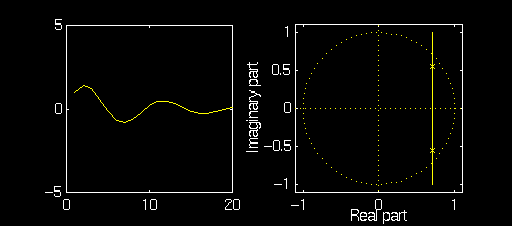

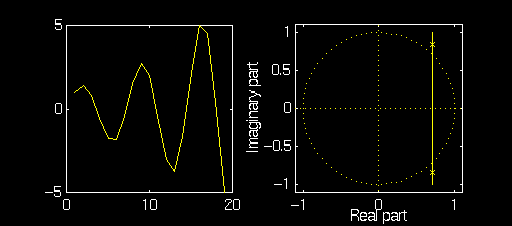
Note that as \(a_2\) is changed the the poles move along a vertical line
that intersects the \(x\)-axis at \(x = \cos(\frac{\pi}4)\)
The filter coefficient
\(a_2\) can also be seen to affect the frequency of oscillation. This
is because \(a_1\) and \(a_2\) do not provide independent
control over the amplitude and frequency of the ocsillator. Note
also that if \(a_2\) has magnitude less than one the oscillator
decays while if the magnitude of \(a_1\)
is greater than one the oscillator grows over time.
Below are a few examples using the MATLAB tool PeZ.
Example: Second Order Oscillator
Using PeZ in MATLAB we can easily generate complex pole pairs. For an oscillator that does not decay we must be careful to place the poles on the unit circle. We will use the edit by coordinate feature of PeZ to insure proper pole placement:

Note the poles have magnitude equal to one and angles equal to \(\frac{\pi}8\). Pez returns the following for plots for the impulse and frequency response:
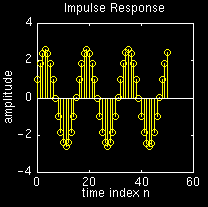

While it is difficult to measure the frequency of the oscillator
from the above graph it can be seen to be approximately
\(\frac{2\pi}{16}\), which is the value we expected.
Example: Decaying Oscillator
By choosing \(r<1\), we can generate a sinusoid that decays over time. As an illustration, lets start with previous example and observe how the impulse reponse is affected by decreasing the magnitude \(r\) from from \(1\) to \(0.925\) (the angle is held fixed at \(n/8\):Here are the plots for \(r=1\):
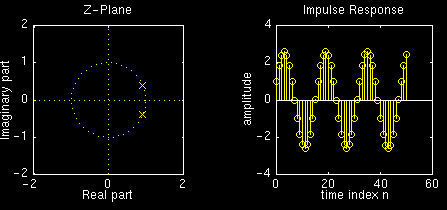
Now here are the plots for \(r=0.975\):
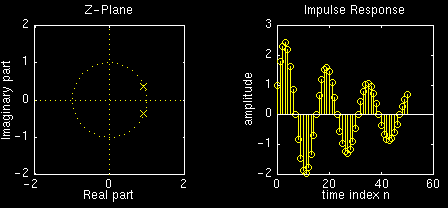
Now here are the plots for \(r=0.95\):
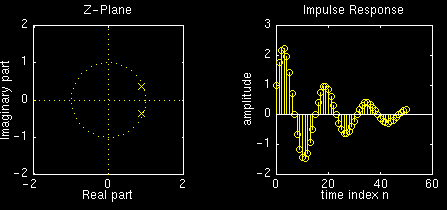
Now here are the plots for \(r=0.925\):

Note how the amplitude of the impulse reponse decays faster with smaller values of \(r\).
Example: Growing Oscillator
By choosing \(r<1\), we can generate a sinusoid that grows over time. As an illustration, lets start with previous example and observe how the impulse reponse is affected by increasing the magnitude \(r\) from from \(1\) to \(1.075\):Here are the plots for \(r=1\):

Now here are the plots for \(r=1.025\):

Now here are the plots for \(r=1.05\):
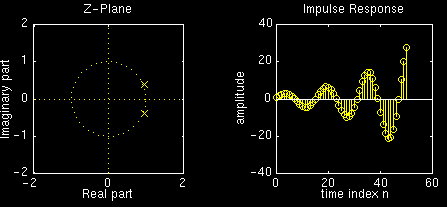
Now here are the plots for \(r=1.075\):

Note how the amplitude of the impulse reponse decays faster with smaller values of \(r\).
